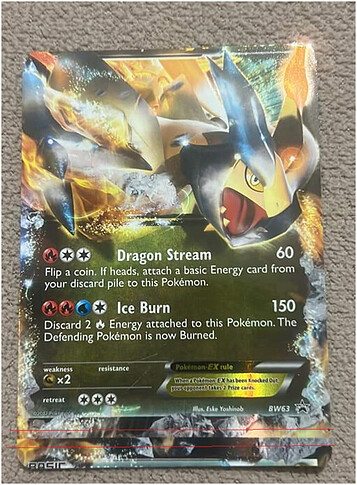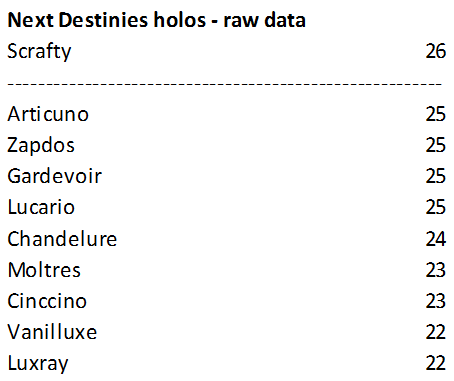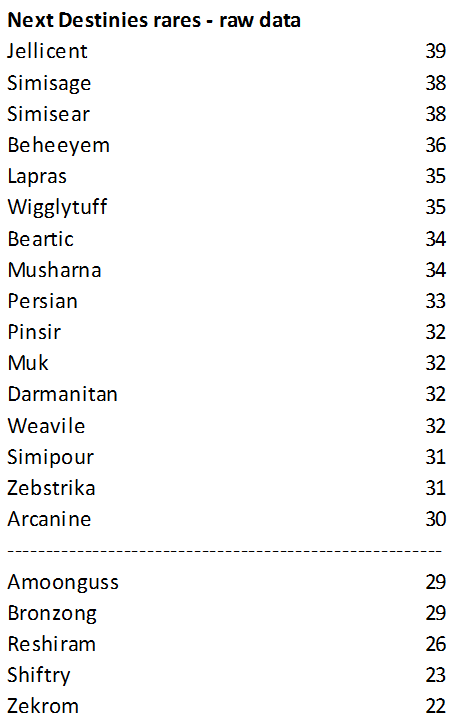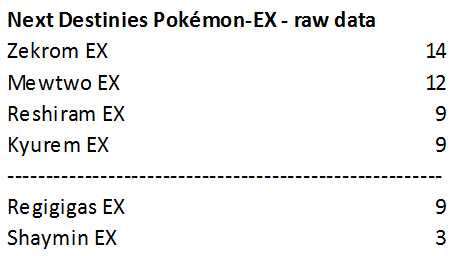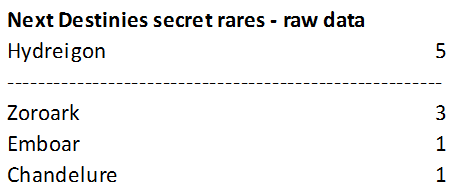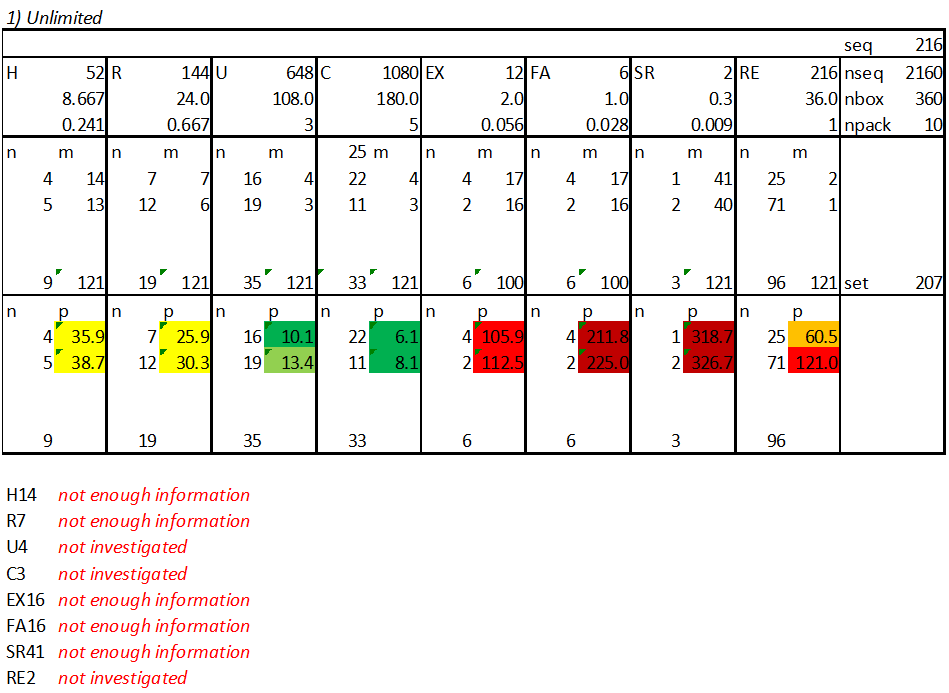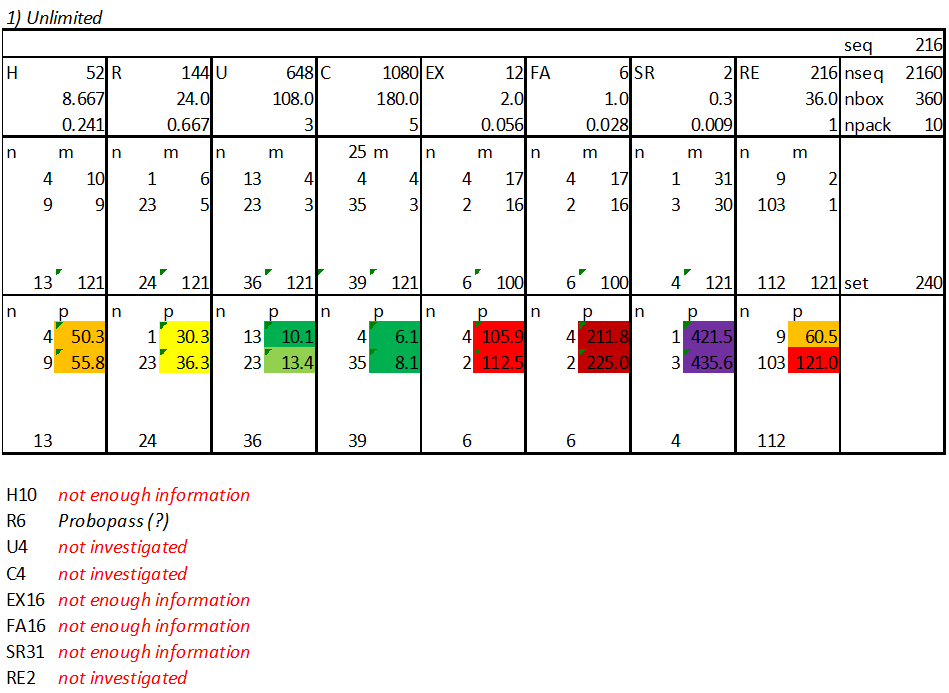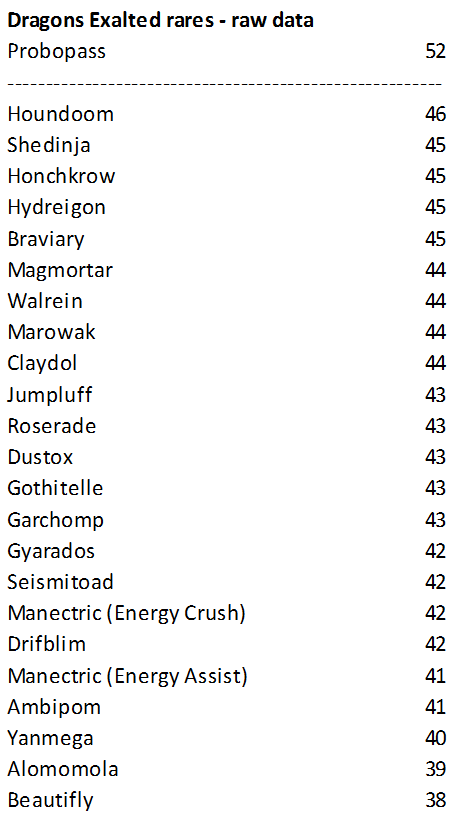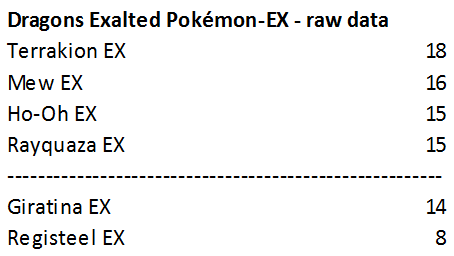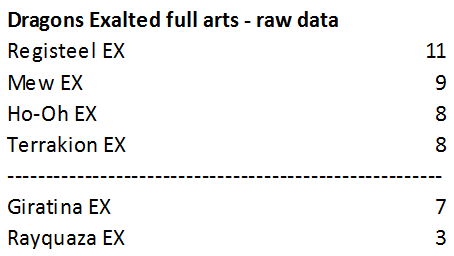XY
For XY Base Set, there are a lot of interesting things to go talk about. The set has no secret rares, so the sheets used for printing the set can be assumed to be commons, uncommons, rares, rare holos, Pokémon-EX, full arts as well as two reverse sheets (the set has 124 reverses, including both art variants of Vivillon, which wouldn’t fit on one sheet).
Looking at the box ratios, a sample of 29 boxes opened on Youtube yielded 8.34 holos, 2.93 Pokémon-EX and and 1.03 full arts. That’s 12.31 “heavy” packs per box.
Now, is that statisticly relevant? I am not going to do the math, as the box ratios aren’t really random and I thus wouldn’t know where to begin, but I can compare with earlier sets. To put it bluntly, it is unusual, as generally the average from the sample is between 11.90 and 12.10 provided it’s not a set with a tiny sample due to only very few videos of box openings available on Youtube.
If I exclude the sets where the sample is less than 14 boxes (504 packs), as well as Neo Destiny (“error” boxes affecting the average) and Legendary Treasures (far more than 12 “hits” per box), the outliers so far are:
- Plasma Storm - 12.21 “hits”
- Skyridge - 11.47 “hits”
- Jungle - 11.73 “hits”
All other sets starting with Rising Rivals have a sample size of at least 14 boxes and the total number of “hits” is between 11.90 and 12.10.
That Plasma Storm has more hits per box on average than other sets could potentially be due to the fact that non-holo rares were accidentally included in the uncommon slots in some boxes and the printing company may have thus ended up with a bunch of extra “hits” which led to them increasing the box ratios slightly for a part of the print run. But that is of course only speculation.
As to Skyridge and Jungle, I have no real explanation except that I am pretty confident that the “missing” holos from Skyridge aren’t simply ones I missed when watching the videos on Youtube as they take the place of a common in the packs. It must also be noted that the sample size isn’t huge (15 boxes each).
Back to XY Base Set. The number of hits, 12.31, is high enough that I am going to go with the hypothesis that for some reason, whether accidentally or intentionally, there are more than 12 “hits” per box on average. Thus I will be assuming three “regular” Pokémon-EX, one full art and 8.4 holos per box in my model. Why 8.4 holos and not 8.3? Just gut feeling, 8.4 is a “rounder” number.
The rarity table looks as follows:
It is interesting that the holo, rare and common sheets all seem to include “artificial” rarity differences (i.e. ones not simply due to sheet size), and the Pokémon-EX sheet may as well, though this is uncertain and I chose not to model it.
For the holos, the card at issue is Vivillon, which in the English set comes in two artwork variants: Meadow and High Plains. Looking at the raw data below, I would assume that the pull rate of both combined is about the same as that of the other holos, thus I am assigning H4 rarity to each variant:
(The dashed lines indicate where the transition from H8 to H7, etc., would occur.)
The raw data for the rares gives me the impression that Xerneas and Yveltal are rarer than the other ones. These are the two cards which are featured as holos in the theme decks. Were it only a matter of the raw data for this single set, I might ignore it, but with the same thing happening in future sets as well, I don’t think it is just coincidence. I am modelling the two as R3 cards, as this best fits the raw data. The raw data below also leads me to guess that the five R4 cards are Simisage, Simisear, Simipour and both variants of Wigglytuff, particularly since their pre-evolutions are all C2 cards:
I did not look at the uncommons, but I reconstructed the commons sheet. It looks as follows (dagger marks indicating it is not possible to tell where it begins and ends):
† Pumpkaboo, Bidoof, Skiddo, Pansear, Honedge, Spoink, Pawniard, Jigglypuff (Rollout), Fennekin, Rhyhorn, Panpour, Ekans, Fletchling, Shellder, Taillow, Timburr, Pikachu, Darkness Energy, Weedle, Zorua, Venipede, Skitty, Fairy Energy, Diglett, Chespin, Fighting Energy, Swirlix, Phantump, Lillipup, Inkay, Ledyba, Spritzee, Psychic Energy, Staryu, Doduo, Pumpkaboo, Jigglypuff (Rollout), Slugma, Honedge, Froakie, Bunnelby, Sandile, Voltorb, Skiddo, Scatterbug, Weedle, Rhyhorn, Bidoof, Spoink, Pawniard, Timburr, Fennekin, Grass Energy, Pikachu, Pansage, Fairy Energy, Venipede, Jigglypuff (Body Slam), Ledyba, Sandile, Diglett, Taillow, Ekans, Lillipup, Doduo, Slugma, Fire Energy, Froakie, Skitty, Shellder, Fletchling, Swirlix, Staryu, Pansear, Chespin, Inkay, Phantump, Bunnelby, Pumpkaboo, Panpour, Scatterbug, Water Energy, Rhyhorn, Honedge, Bidoof, Pikachu, Spritzee, Venipede, Skiddo, Zorua, Ekans, Timburr, Lightning Energy, Weedle, Fairy Energy, Skitty, Spoink, Pawniard, Fletchling, Fennekin, Voltorb, Chespin, Taillow, Spritzee, Ledyba, Lillipup, Froakie, Sandile, Diglett, Jigglypuff (Body Slam), Shellder, Phantump, Metal Energy, Inkay, Slugma, Pansage, Staryu, Swirlix, Scatterbug, Doduo, Bunnelby †
It is interesting that there are 32 C3 and 7 C2 Pokémon, and 8 of the 9 Basic Energy Cards have C1 rarity, but Fairy Energy is a C3 card. That makes sense though, as it would have been in a lot of demand from players.
The raw data for the Pokémon-EX looks as follows:

There are a lot of Blastoise EX and Venusaur EX, which is interesting as those are the two Pokémon with a Mega Evolution. I looked at the other XY era sets to see if that might be a trend, but it doesn’t seem to be. So I am assuming it’s just coincidence, and there are no artificial rarity differences here.
The raw data for the full arts is as follows - nothing unusual about it:

For the reverses, observed data for a sub-sample fits a hypothesis where the six reverses appearing only once on the two reverse sheets combined are all reverses rare holos:

Edit 2024/03/24: Changed sequence length from 216 to 360. This has a minor impact on the holo and non-holo rare pull rates.
